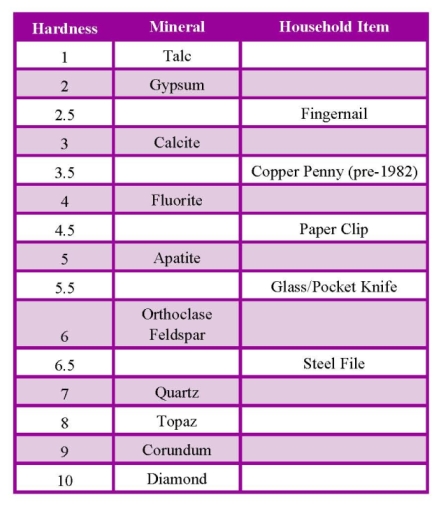How many characteristics of a mineral are there?
5
How many physical properties of a mineral are there?
7
Give 1 example for how the mineral Copper is used.
Pennies
Wiring
What does the Moh's Hardness Scale measure?
The hardness of minerals
What physical property should NEVER be used as the main way you identify a mineral?
Color
What acronym is used to remember the 5 characteristics of a mineral?
SNIFC
Name the 7 physical properties of minerals.
Color, luster, hardness, streak, cleavage, fracture and density
Give 1 example for how the mineral Fluorite is used.
Toothpaste
Water
The Moh's Hardness Scale ranks minerals from ______________ to _____________.
Softest to hardest
Which mineral is harder: Calcite (3) or Topaz (8)?
Topaz (8)
What do each of the letters in SNIFC stand for?
S- solid
N- natural
I- inorganic
F- fixed composition
C- crystalline structure
Name the 2 types of luster.
Metallic and non-metallic
What mineral is used in baby powder?
Talc
Name the softest mineral and the hardest mineral on the Moh's Hardness Scale.
Softest- Talc
Hardest- Diamond
Does this mineral have a metallic or non-metallic luster?
Non-metallic
Explain what it means for something to be NATURAL and INORGANIC
Natural- made from the Earth, not man-made
Inorganic- not alive: never has been and never will be
Explain the difference between cleavage and fracture.
Cleavage- when a mineral breaks along smooth, flat planes *geometric*
Fracture- when a mineral breaks irregularly *broken bone*
Give 1 use for the mineral GYPSUM.
Wall board/dry wall

What mineral CAN SCRATCH a paperclip and can BE SCRATCHED BY glass?
Apatite
Give an example of something with a fixed composition and something without a fixed composition.
Varies
Explain why ice IS a mineral and why water IS NOT.
Ice is solid, comes from nature, is not living, has a fixed composition and a crystalline structure.
Water is liquid and doesn't have a crystalline structure so it cannot be a mineral even though it is natural, is not living, has a fixed composition.
Explain how you find the hardness of a mineral using the Moh's Hardness Scale.
First you try to scratch the mineral with the softest mineral/object (Talc or a fingernail). If you are not able to scratch the mineral, you know that the mineral is softer than Talc or a fingernail. If you are able to scratch the mineral, you know that the mineral is harder than Talc or a fingernail and you continue trying to scratch the mineral with different minerals/objects until you can't scratch anything else.
Give 2 examples of how the mineral DIAMOND is used.
Jewelry
Tools
 Using minerals and household items from the Moh's Hardness Scale, give an example of a mineral that can scratch something and be scratched by something else
Using minerals and household items from the Moh's Hardness Scale, give an example of a mineral that can scratch something and be scratched by something else
Varies
Is this object a mineral? Explain why or why not.
Plastic straws are not minerals because they are not made in nature and don't have a crystalline structure
Even though they're solid, inorganic, and have a fixed composition